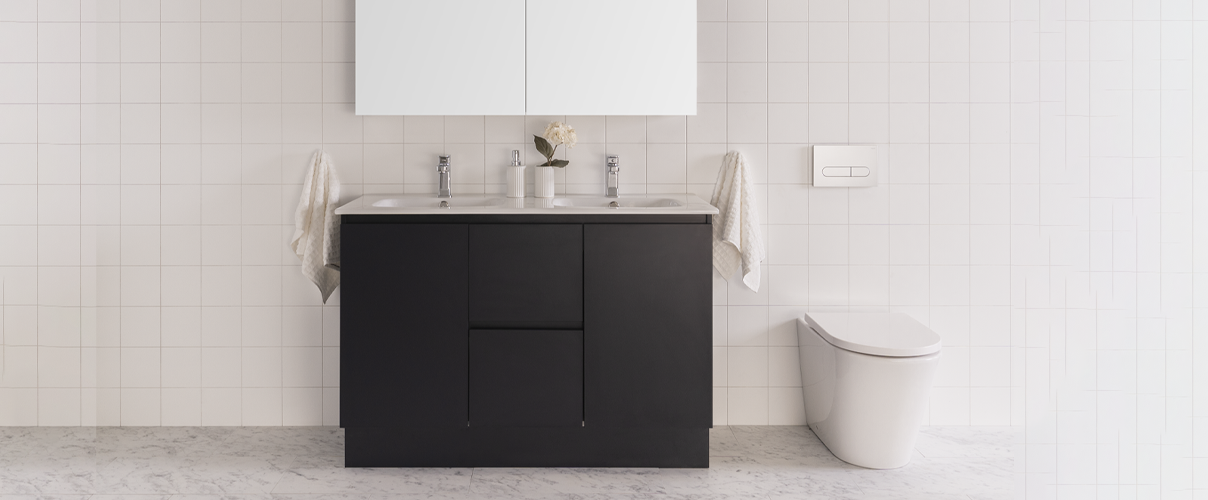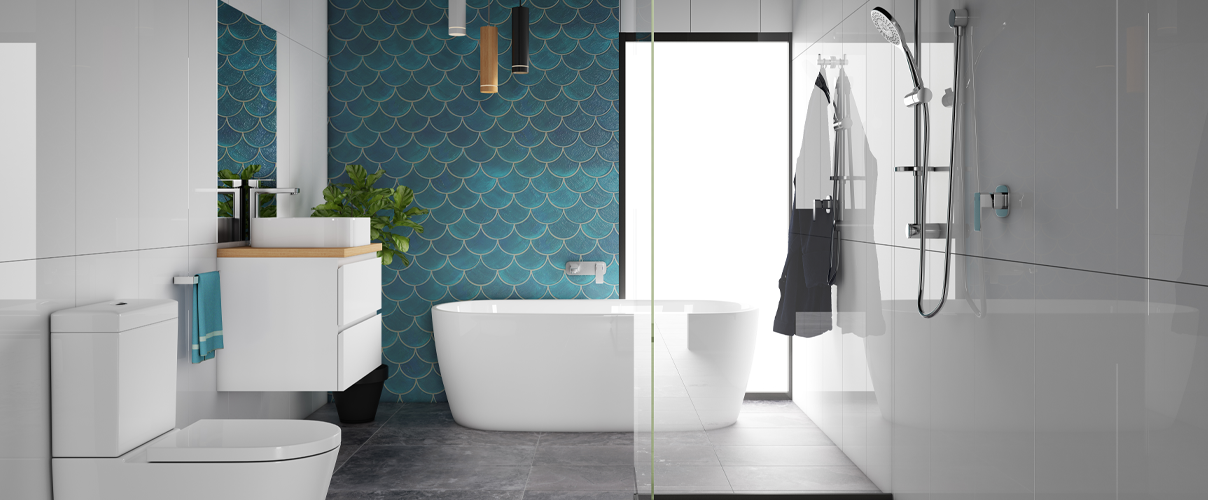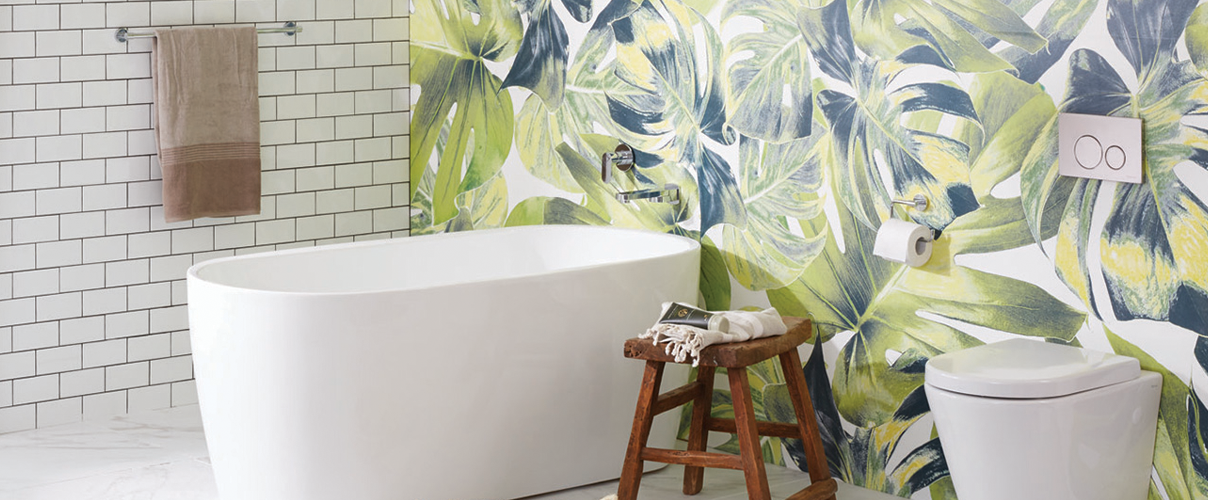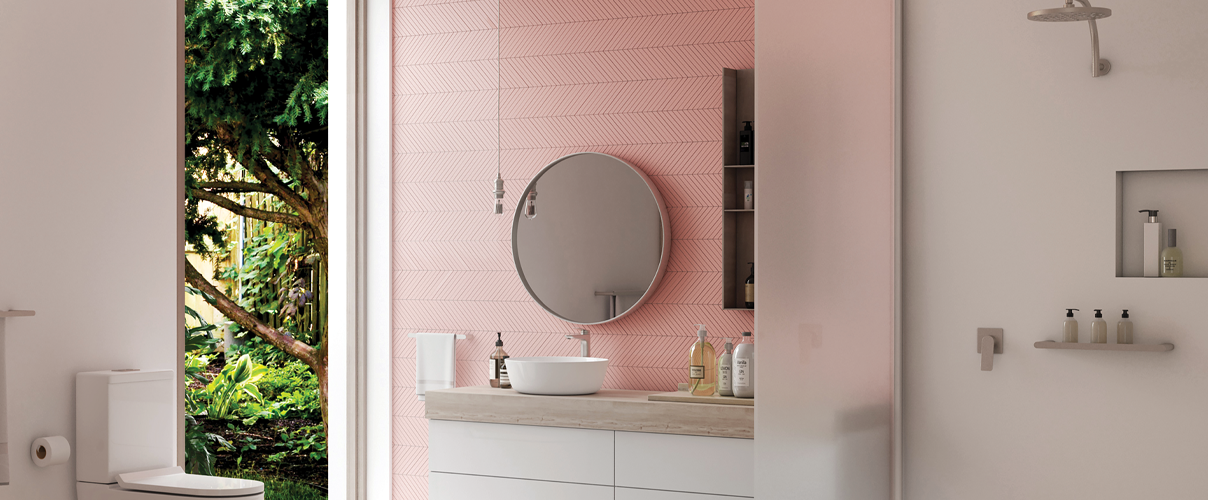Using Block, Bold Colours in the Bathroom

Have one or two colours you really love? Why not just go for it with block bold colours?
Homeowners are now being bolder with their colour choices, cranking the volume right up to the max. If you’re ready to give it a go, here are some tips for using block, bold colours in your bathroom.
Baby Steps With Bold Bath Towels
It’s perfectly normal to feel a little colour-shy. Home bathrooms are typically just so whi te! Breaking the mould is not easy – even when the block colour trend is gaining traction.
Take baby steps by starting with bright bath towels and mats – either the same colour or complementing colours. However, two separate block colour pieces alone might look stagnated. Pot plants, wall art, stools and soap dispensers in similar colours or tones to the block colours will help to harmonise the area.

Brave Feature Pieces
Coloured baths, vanities and basins introduce block colours without overwhelming the space. Modern technology allows designers and manufacturers to become more and more creative with these bathroom products, using different materials, methods and finishes. This means more ways for you to inject your personality into your bathroom design.
We absolutely love this Minka solid surface bath in forest green by Fienza and the matching above counter pill basin . The texture of the fluted outer edge adds depth to the whole room design. The green tone also perfectly lends itself to using simple plants to tie the space together.
Coloured vanities are also gaining popularity. For example, our Raymor range of vanities comes in seven different colours, including black, Oxford blue, grey nouveau, oak, walnut, plantation ash, and amaro.
Block Colours For Walls And Floors
Take things a step further with coloured tiles on the floor, walls or both. Painted walls are also a simple and cost-effective way to introduce block colour, leaving the tiles just for wet areas.
Wall colours that blend with feature baths or vanities create a stunning, cohesive look. Walls that are a shade lighter or darker than other feature pieces add depth and subtle contrast. If everything is too similar, the room could become disorienting.

Feature Wall
Not willing to commit to a wash of colour? Create a feature wall or utilise slight tonal changes to add definition and interest. In this bathroom, the lovely blue-green shade of teal for a feature wall provides a beautiful pop of colour in contrast to the traditional neutral tones of the modern bath and white floor and walls. The wooden accents work to blend the two together, and the textured tiles enhance the detail.
Half Tiled Wall
A different type of feature is to tile the walls halfway. Some people prefer this over the feature wall because it offers a different balance by wrapping the feature colour around the room.
Combine Two Or More Of Your Favourites
By no means do you have to pick just one of your favourite colours! Mix different colours for a super bold look. Make sure they’re colours that work in harmony. This can be achieved in different ways:
Monochromatic colours – different hues of one colour. Think pale blue and navy blue. This cohesive look can be very calming.
Analogous colours – those that are similar to each other and exist next to each other on a colour wheel. For example, blue-green, green, and yellow-green. This is interesting without being too bold.
Complementary colours – opposite colours on a colour wheel, such as yellow and purple. This give the room an energetic feel.
Triadic – perhaps the most adventurous approach, the triadic colour scheme uses three colours equally spaced apart on a colour wheel. Usually one colour is the dominant colour and the other two are used as accents.

Full-length Wall Graphics
Getting creative with graphics is an exciting way to introduce block colours, even in bathrooms! Use paint, prints or tiles to create different patterns or images. Get more inspiration from our lifestyle blog article Let’s get graphically creative!
Merge Surfaces
By painting your walls and skirting boards in a single colour or using the same tile from wall to floor, you can create the illusion that your surfaces are merging. This look doesn’t have to cover the entire bathroom but could be dedicated to a zone. The popular option is to use the same tiles for the floor and wall in the shower, then different tiles or colours for the rest of the bathroom.
While floor tiles can generally be used on walls, the same can’t be said in reverse. Wall tiles are generally more decorative and not durable enough to withstand foot traffic and furnishings.

Go Bold With Softer Shades
Muted tones can still be bold. A subtle blush pink used in block and feature colours of a bathroom is just as dramatic as forest green. It’s all about what makes you smile.
For the latest colour inspiration, see our blog about Trending colours for kitchens, bathrooms and laundries .
Remember The Rules Of Colour
Colours are fun, but they still have rules. Of course, there are no colour police to stop you from doing what you want, but sticking to the rules will give you the best results.
We tend to stand by the 60-30-10 rule. This allows for 60% of the room to be in the dominant colour – usually your most neutral colour or tone; 30% of the room in your secondary colour, and 10% in your accent colour. The rule of three is another useful way to decide on your accent pieces: use the accent colour in three places like your mirror frame, accessories and tapware.
Shop The Range At Tradelink
At Tradelink, we have an extensive collection of bathroom products in different colours. You’re sure to find a bath, vanity, basin or even tapware in the colour you love, or to complement your favourite paint and tiles.
Browse online or shop the range in store where you can gain inspiration from our showroom displays plus advice from our knowledgeable showroom consultants.
You can also play around with different colour themes using our Style Sourcebook Moodboard tool. See how your favourite colours can come to life in your bathroom.

